Case Study: Australian Immigration Policies and Asylum Seekers
VerifiedAdded on 2021/06/14
|7
|1717
|43
Case Study
AI Summary
This case study examines the complex situation of asylum seekers in Australia, focusing on the policies and practices of the Australian government, particularly concerning the offshore detention centers on Nauru and Manus Island. It details the struggles of asylum seekers seeking refuge, the government's efforts to control immigration, and the resulting human rights concerns. The case study explores the harsh conditions in detention camps, including inadequate medical care, violence, and the denial of legal rights, as well as the impact of international influence on Australian policies. It also analyzes the evolution of Australian immigration laws, the role of political figures, and the ongoing debate surrounding the treatment of asylum seekers, drawing from various sources to provide a comprehensive overview of the problem and its implications.
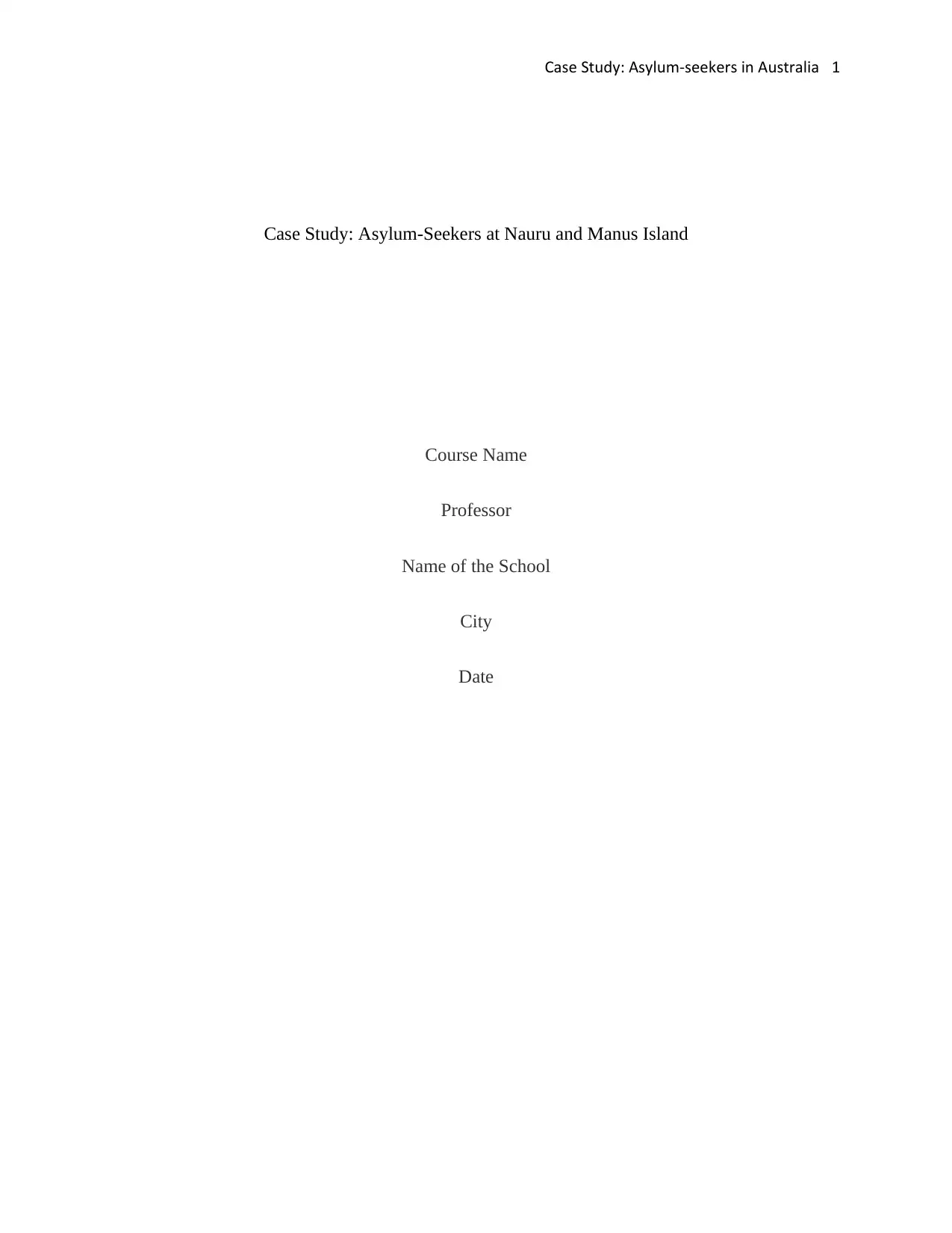
Case Study: Asylum-seekers in Australia 1
Case Study: Asylum-Seekers at Nauru and Manus Island
Course Name
Professor
Name of the School
City
Date
Case Study: Asylum-Seekers at Nauru and Manus Island
Course Name
Professor
Name of the School
City
Date
Paraphrase This Document
Need a fresh take? Get an instant paraphrase of this document with our AI Paraphraser
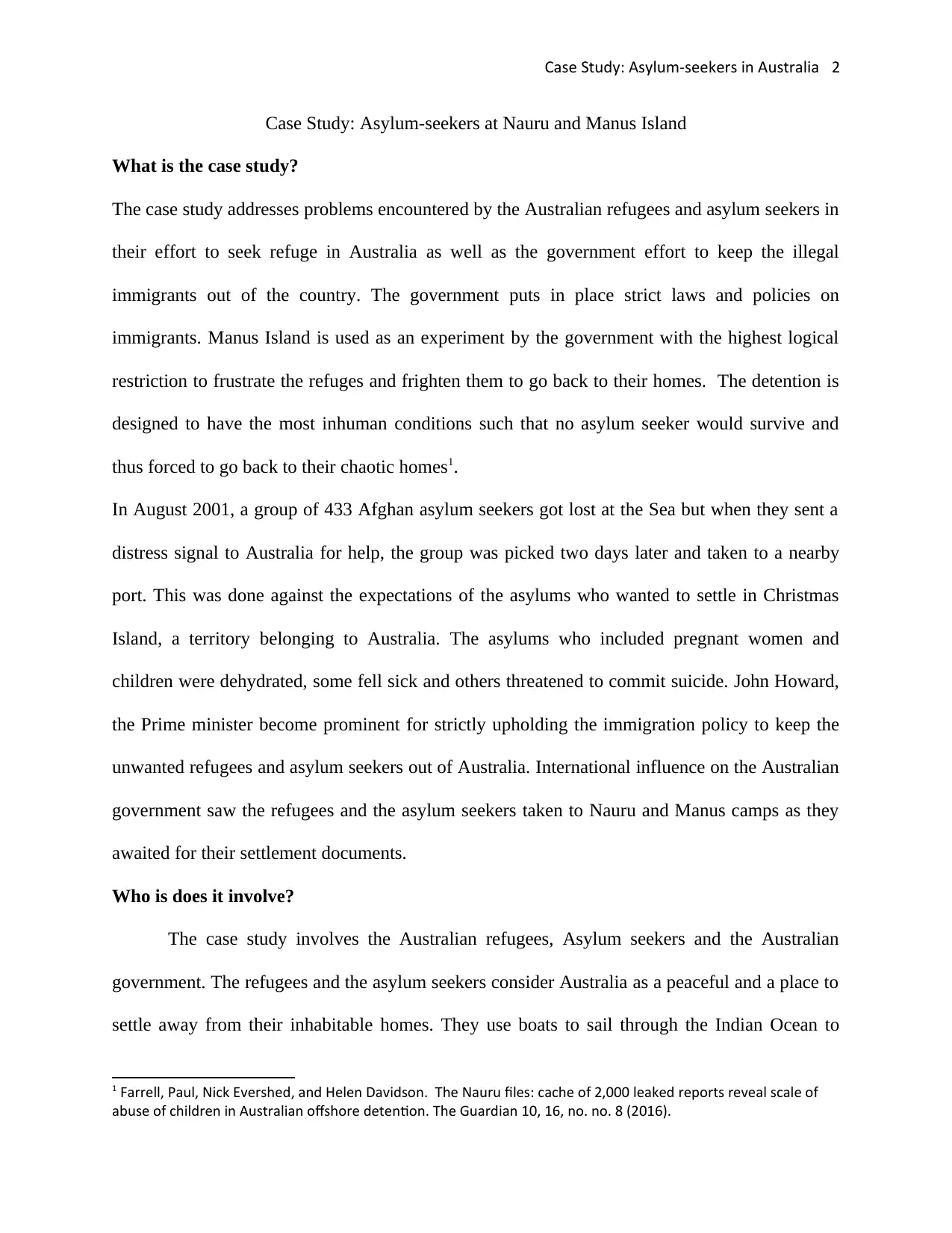
Case Study: Asylum-seekers in Australia 2
Case Study: Asylum-seekers at Nauru and Manus Island
What is the case study?
The case study addresses problems encountered by the Australian refugees and asylum seekers in
their effort to seek refuge in Australia as well as the government effort to keep the illegal
immigrants out of the country. The government puts in place strict laws and policies on
immigrants. Manus Island is used as an experiment by the government with the highest logical
restriction to frustrate the refuges and frighten them to go back to their homes. The detention is
designed to have the most inhuman conditions such that no asylum seeker would survive and
thus forced to go back to their chaotic homes1.
In August 2001, a group of 433 Afghan asylum seekers got lost at the Sea but when they sent a
distress signal to Australia for help, the group was picked two days later and taken to a nearby
port. This was done against the expectations of the asylums who wanted to settle in Christmas
Island, a territory belonging to Australia. The asylums who included pregnant women and
children were dehydrated, some fell sick and others threatened to commit suicide. John Howard,
the Prime minister become prominent for strictly upholding the immigration policy to keep the
unwanted refugees and asylum seekers out of Australia. International influence on the Australian
government saw the refugees and the asylum seekers taken to Nauru and Manus camps as they
awaited for their settlement documents.
Who is does it involve?
The case study involves the Australian refugees, Asylum seekers and the Australian
government. The refugees and the asylum seekers consider Australia as a peaceful and a place to
settle away from their inhabitable homes. They use boats to sail through the Indian Ocean to
1 Farrell, Paul, Nick Evershed, and Helen Davidson. The Nauru files: cache of 2,000 leaked reports reveal scale of
abuse of children in Australian offshore detention. The Guardian 10, 16, no. no. 8 (2016).
Case Study: Asylum-seekers at Nauru and Manus Island
What is the case study?
The case study addresses problems encountered by the Australian refugees and asylum seekers in
their effort to seek refuge in Australia as well as the government effort to keep the illegal
immigrants out of the country. The government puts in place strict laws and policies on
immigrants. Manus Island is used as an experiment by the government with the highest logical
restriction to frustrate the refuges and frighten them to go back to their homes. The detention is
designed to have the most inhuman conditions such that no asylum seeker would survive and
thus forced to go back to their chaotic homes1.
In August 2001, a group of 433 Afghan asylum seekers got lost at the Sea but when they sent a
distress signal to Australia for help, the group was picked two days later and taken to a nearby
port. This was done against the expectations of the asylums who wanted to settle in Christmas
Island, a territory belonging to Australia. The asylums who included pregnant women and
children were dehydrated, some fell sick and others threatened to commit suicide. John Howard,
the Prime minister become prominent for strictly upholding the immigration policy to keep the
unwanted refugees and asylum seekers out of Australia. International influence on the Australian
government saw the refugees and the asylum seekers taken to Nauru and Manus camps as they
awaited for their settlement documents.
Who is does it involve?
The case study involves the Australian refugees, Asylum seekers and the Australian
government. The refugees and the asylum seekers consider Australia as a peaceful and a place to
settle away from their inhabitable homes. They use boats to sail through the Indian Ocean to
1 Farrell, Paul, Nick Evershed, and Helen Davidson. The Nauru files: cache of 2,000 leaked reports reveal scale of
abuse of children in Australian offshore detention. The Guardian 10, 16, no. no. 8 (2016).
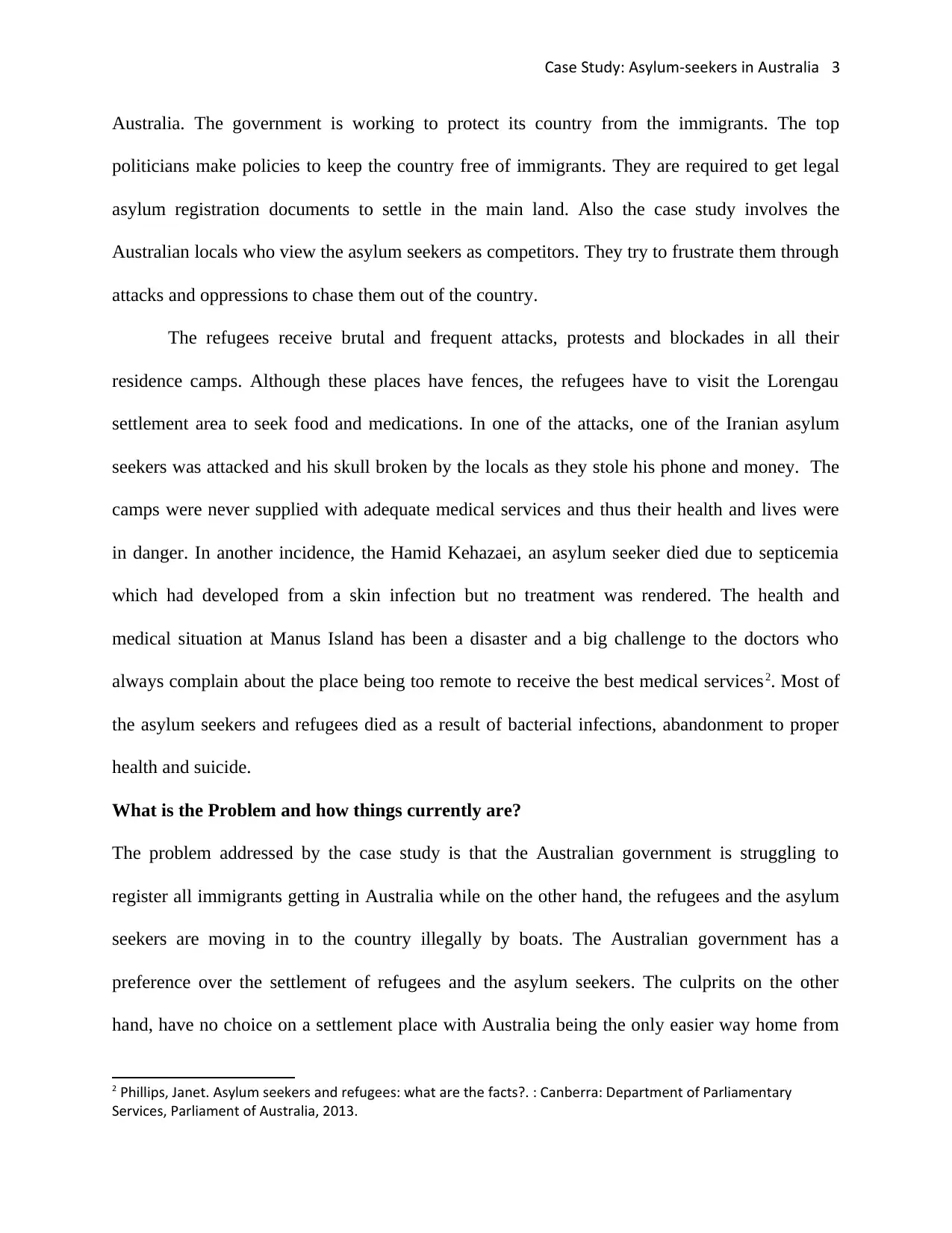
Case Study: Asylum-seekers in Australia 3
Australia. The government is working to protect its country from the immigrants. The top
politicians make policies to keep the country free of immigrants. They are required to get legal
asylum registration documents to settle in the main land. Also the case study involves the
Australian locals who view the asylum seekers as competitors. They try to frustrate them through
attacks and oppressions to chase them out of the country.
The refugees receive brutal and frequent attacks, protests and blockades in all their
residence camps. Although these places have fences, the refugees have to visit the Lorengau
settlement area to seek food and medications. In one of the attacks, one of the Iranian asylum
seekers was attacked and his skull broken by the locals as they stole his phone and money. The
camps were never supplied with adequate medical services and thus their health and lives were
in danger. In another incidence, the Hamid Kehazaei, an asylum seeker died due to septicemia
which had developed from a skin infection but no treatment was rendered. The health and
medical situation at Manus Island has been a disaster and a big challenge to the doctors who
always complain about the place being too remote to receive the best medical services2. Most of
the asylum seekers and refugees died as a result of bacterial infections, abandonment to proper
health and suicide.
What is the Problem and how things currently are?
The problem addressed by the case study is that the Australian government is struggling to
register all immigrants getting in Australia while on the other hand, the refugees and the asylum
seekers are moving in to the country illegally by boats. The Australian government has a
preference over the settlement of refugees and the asylum seekers. The culprits on the other
hand, have no choice on a settlement place with Australia being the only easier way home from
2 Phillips, Janet. Asylum seekers and refugees: what are the facts?. : Canberra: Department of Parliamentary
Services, Parliament of Australia, 2013.
Australia. The government is working to protect its country from the immigrants. The top
politicians make policies to keep the country free of immigrants. They are required to get legal
asylum registration documents to settle in the main land. Also the case study involves the
Australian locals who view the asylum seekers as competitors. They try to frustrate them through
attacks and oppressions to chase them out of the country.
The refugees receive brutal and frequent attacks, protests and blockades in all their
residence camps. Although these places have fences, the refugees have to visit the Lorengau
settlement area to seek food and medications. In one of the attacks, one of the Iranian asylum
seekers was attacked and his skull broken by the locals as they stole his phone and money. The
camps were never supplied with adequate medical services and thus their health and lives were
in danger. In another incidence, the Hamid Kehazaei, an asylum seeker died due to septicemia
which had developed from a skin infection but no treatment was rendered. The health and
medical situation at Manus Island has been a disaster and a big challenge to the doctors who
always complain about the place being too remote to receive the best medical services2. Most of
the asylum seekers and refugees died as a result of bacterial infections, abandonment to proper
health and suicide.
What is the Problem and how things currently are?
The problem addressed by the case study is that the Australian government is struggling to
register all immigrants getting in Australia while on the other hand, the refugees and the asylum
seekers are moving in to the country illegally by boats. The Australian government has a
preference over the settlement of refugees and the asylum seekers. The culprits on the other
hand, have no choice on a settlement place with Australia being the only easier way home from
2 Phillips, Janet. Asylum seekers and refugees: what are the facts?. : Canberra: Department of Parliamentary
Services, Parliament of Australia, 2013.
⊘ This is a preview!⊘
Do you want full access?
Subscribe today to unlock all pages.

Trusted by 1+ million students worldwide
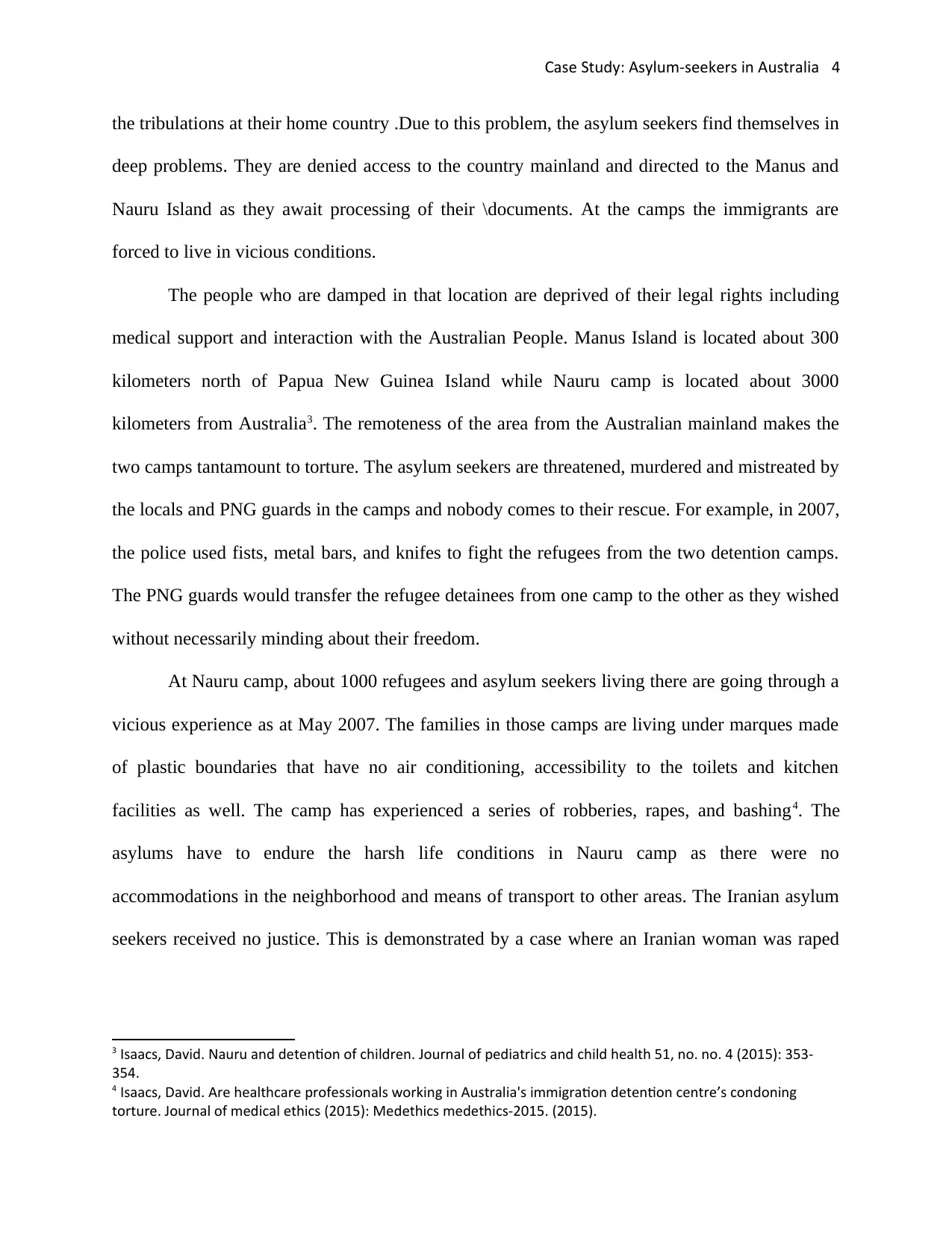
Case Study: Asylum-seekers in Australia 4
the tribulations at their home country .Due to this problem, the asylum seekers find themselves in
deep problems. They are denied access to the country mainland and directed to the Manus and
Nauru Island as they await processing of their \documents. At the camps the immigrants are
forced to live in vicious conditions.
The people who are damped in that location are deprived of their legal rights including
medical support and interaction with the Australian People. Manus Island is located about 300
kilometers north of Papua New Guinea Island while Nauru camp is located about 3000
kilometers from Australia3. The remoteness of the area from the Australian mainland makes the
two camps tantamount to torture. The asylum seekers are threatened, murdered and mistreated by
the locals and PNG guards in the camps and nobody comes to their rescue. For example, in 2007,
the police used fists, metal bars, and knifes to fight the refugees from the two detention camps.
The PNG guards would transfer the refugee detainees from one camp to the other as they wished
without necessarily minding about their freedom.
At Nauru camp, about 1000 refugees and asylum seekers living there are going through a
vicious experience as at May 2007. The families in those camps are living under marques made
of plastic boundaries that have no air conditioning, accessibility to the toilets and kitchen
facilities as well. The camp has experienced a series of robberies, rapes, and bashing4. The
asylums have to endure the harsh life conditions in Nauru camp as there were no
accommodations in the neighborhood and means of transport to other areas. The Iranian asylum
seekers received no justice. This is demonstrated by a case where an Iranian woman was raped
3 Isaacs, David. Nauru and detention of children. Journal of pediatrics and child health 51, no. no. 4 (2015): 353-
354.
4 Isaacs, David. Are healthcare professionals working in Australia's immigration detention centre’s condoning
torture. Journal of medical ethics (2015): Medethics medethics-2015. (2015).
the tribulations at their home country .Due to this problem, the asylum seekers find themselves in
deep problems. They are denied access to the country mainland and directed to the Manus and
Nauru Island as they await processing of their \documents. At the camps the immigrants are
forced to live in vicious conditions.
The people who are damped in that location are deprived of their legal rights including
medical support and interaction with the Australian People. Manus Island is located about 300
kilometers north of Papua New Guinea Island while Nauru camp is located about 3000
kilometers from Australia3. The remoteness of the area from the Australian mainland makes the
two camps tantamount to torture. The asylum seekers are threatened, murdered and mistreated by
the locals and PNG guards in the camps and nobody comes to their rescue. For example, in 2007,
the police used fists, metal bars, and knifes to fight the refugees from the two detention camps.
The PNG guards would transfer the refugee detainees from one camp to the other as they wished
without necessarily minding about their freedom.
At Nauru camp, about 1000 refugees and asylum seekers living there are going through a
vicious experience as at May 2007. The families in those camps are living under marques made
of plastic boundaries that have no air conditioning, accessibility to the toilets and kitchen
facilities as well. The camp has experienced a series of robberies, rapes, and bashing4. The
asylums have to endure the harsh life conditions in Nauru camp as there were no
accommodations in the neighborhood and means of transport to other areas. The Iranian asylum
seekers received no justice. This is demonstrated by a case where an Iranian woman was raped
3 Isaacs, David. Nauru and detention of children. Journal of pediatrics and child health 51, no. no. 4 (2015): 353-
354.
4 Isaacs, David. Are healthcare professionals working in Australia's immigration detention centre’s condoning
torture. Journal of medical ethics (2015): Medethics medethics-2015. (2015).
Paraphrase This Document
Need a fresh take? Get an instant paraphrase of this document with our AI Paraphraser
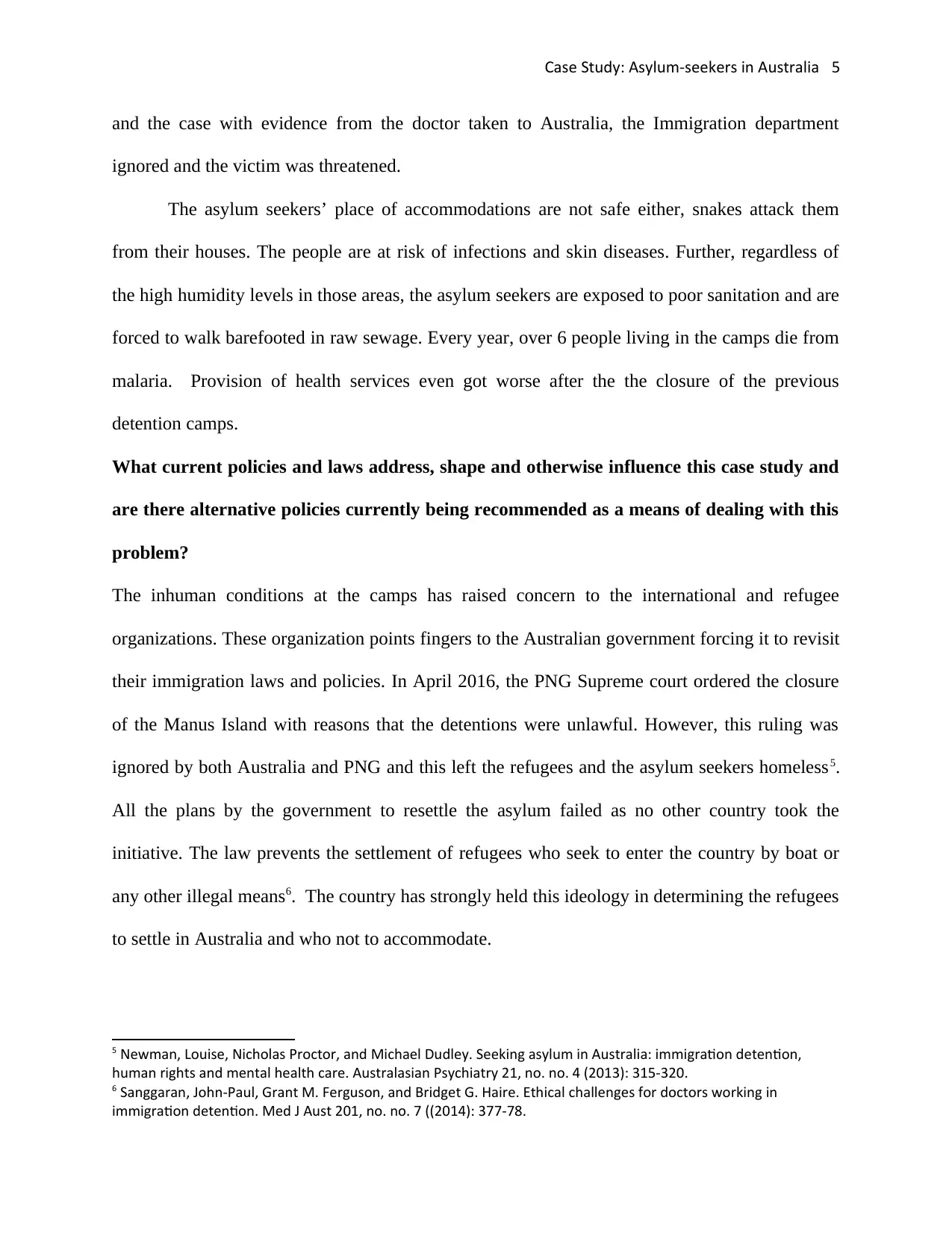
Case Study: Asylum-seekers in Australia 5
and the case with evidence from the doctor taken to Australia, the Immigration department
ignored and the victim was threatened.
The asylum seekers’ place of accommodations are not safe either, snakes attack them
from their houses. The people are at risk of infections and skin diseases. Further, regardless of
the high humidity levels in those areas, the asylum seekers are exposed to poor sanitation and are
forced to walk barefooted in raw sewage. Every year, over 6 people living in the camps die from
malaria. Provision of health services even got worse after the the closure of the previous
detention camps.
What current policies and laws address, shape and otherwise influence this case study and
are there alternative policies currently being recommended as a means of dealing with this
problem?
The inhuman conditions at the camps has raised concern to the international and refugee
organizations. These organization points fingers to the Australian government forcing it to revisit
their immigration laws and policies. In April 2016, the PNG Supreme court ordered the closure
of the Manus Island with reasons that the detentions were unlawful. However, this ruling was
ignored by both Australia and PNG and this left the refugees and the asylum seekers homeless5.
All the plans by the government to resettle the asylum failed as no other country took the
initiative. The law prevents the settlement of refugees who seek to enter the country by boat or
any other illegal means6. The country has strongly held this ideology in determining the refugees
to settle in Australia and who not to accommodate.
5 Newman, Louise, Nicholas Proctor, and Michael Dudley. Seeking asylum in Australia: immigration detention,
human rights and mental health care. Australasian Psychiatry 21, no. no. 4 (2013): 315-320.
6 Sanggaran, John-Paul, Grant M. Ferguson, and Bridget G. Haire. Ethical challenges for doctors working in
immigration detention. Med J Aust 201, no. no. 7 ((2014): 377-78.
and the case with evidence from the doctor taken to Australia, the Immigration department
ignored and the victim was threatened.
The asylum seekers’ place of accommodations are not safe either, snakes attack them
from their houses. The people are at risk of infections and skin diseases. Further, regardless of
the high humidity levels in those areas, the asylum seekers are exposed to poor sanitation and are
forced to walk barefooted in raw sewage. Every year, over 6 people living in the camps die from
malaria. Provision of health services even got worse after the the closure of the previous
detention camps.
What current policies and laws address, shape and otherwise influence this case study and
are there alternative policies currently being recommended as a means of dealing with this
problem?
The inhuman conditions at the camps has raised concern to the international and refugee
organizations. These organization points fingers to the Australian government forcing it to revisit
their immigration laws and policies. In April 2016, the PNG Supreme court ordered the closure
of the Manus Island with reasons that the detentions were unlawful. However, this ruling was
ignored by both Australia and PNG and this left the refugees and the asylum seekers homeless5.
All the plans by the government to resettle the asylum failed as no other country took the
initiative. The law prevents the settlement of refugees who seek to enter the country by boat or
any other illegal means6. The country has strongly held this ideology in determining the refugees
to settle in Australia and who not to accommodate.
5 Newman, Louise, Nicholas Proctor, and Michael Dudley. Seeking asylum in Australia: immigration detention,
human rights and mental health care. Australasian Psychiatry 21, no. no. 4 (2013): 315-320.
6 Sanggaran, John-Paul, Grant M. Ferguson, and Bridget G. Haire. Ethical challenges for doctors working in
immigration detention. Med J Aust 201, no. no. 7 ((2014): 377-78.
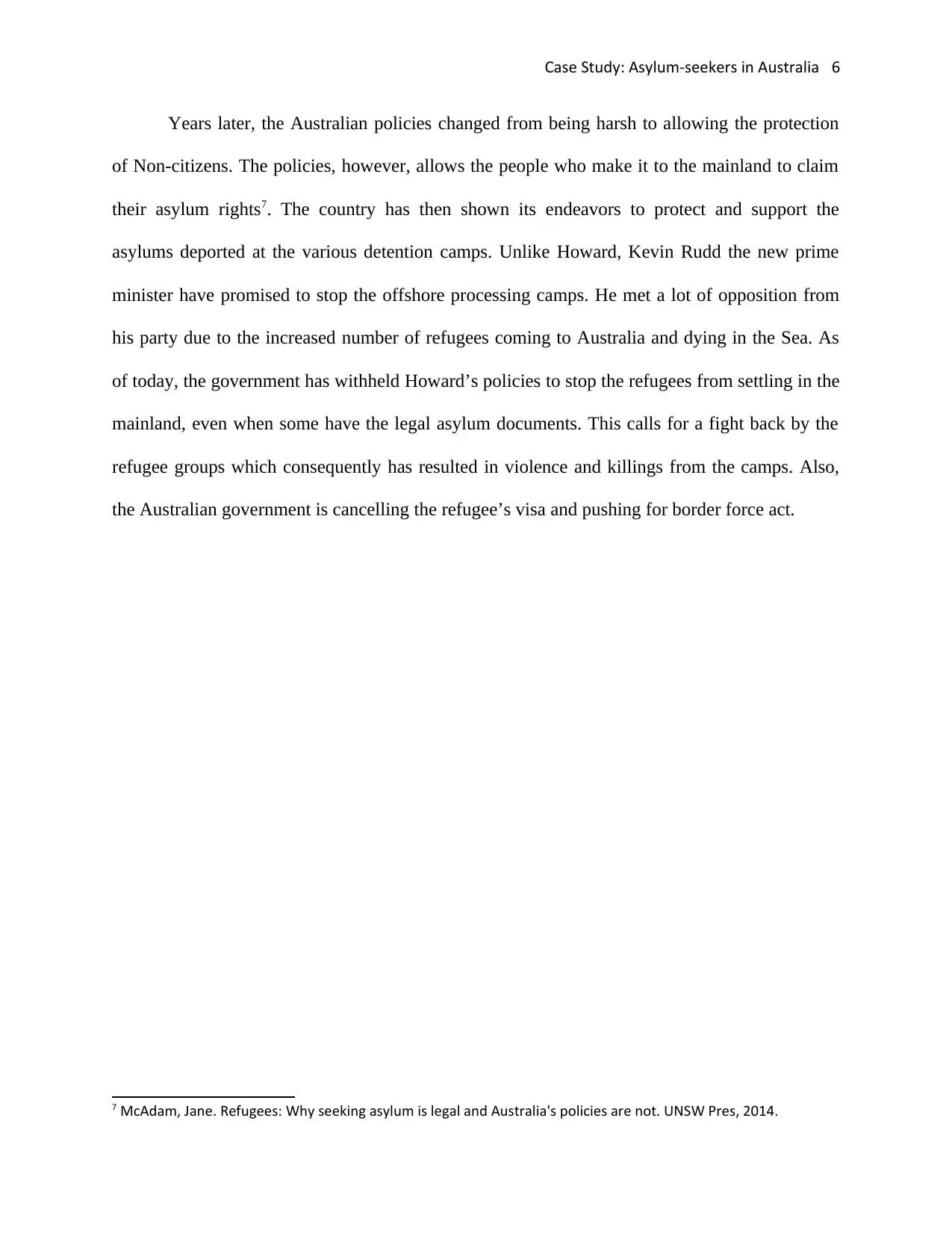
Case Study: Asylum-seekers in Australia 6
Years later, the Australian policies changed from being harsh to allowing the protection
of Non-citizens. The policies, however, allows the people who make it to the mainland to claim
their asylum rights7. The country has then shown its endeavors to protect and support the
asylums deported at the various detention camps. Unlike Howard, Kevin Rudd the new prime
minister have promised to stop the offshore processing camps. He met a lot of opposition from
his party due to the increased number of refugees coming to Australia and dying in the Sea. As
of today, the government has withheld Howard’s policies to stop the refugees from settling in the
mainland, even when some have the legal asylum documents. This calls for a fight back by the
refugee groups which consequently has resulted in violence and killings from the camps. Also,
the Australian government is cancelling the refugee’s visa and pushing for border force act.
7 McAdam, Jane. Refugees: Why seeking asylum is legal and Australia's policies are not. UNSW Pres, 2014.
Years later, the Australian policies changed from being harsh to allowing the protection
of Non-citizens. The policies, however, allows the people who make it to the mainland to claim
their asylum rights7. The country has then shown its endeavors to protect and support the
asylums deported at the various detention camps. Unlike Howard, Kevin Rudd the new prime
minister have promised to stop the offshore processing camps. He met a lot of opposition from
his party due to the increased number of refugees coming to Australia and dying in the Sea. As
of today, the government has withheld Howard’s policies to stop the refugees from settling in the
mainland, even when some have the legal asylum documents. This calls for a fight back by the
refugee groups which consequently has resulted in violence and killings from the camps. Also,
the Australian government is cancelling the refugee’s visa and pushing for border force act.
7 McAdam, Jane. Refugees: Why seeking asylum is legal and Australia's policies are not. UNSW Pres, 2014.
⊘ This is a preview!⊘
Do you want full access?
Subscribe today to unlock all pages.

Trusted by 1+ million students worldwide
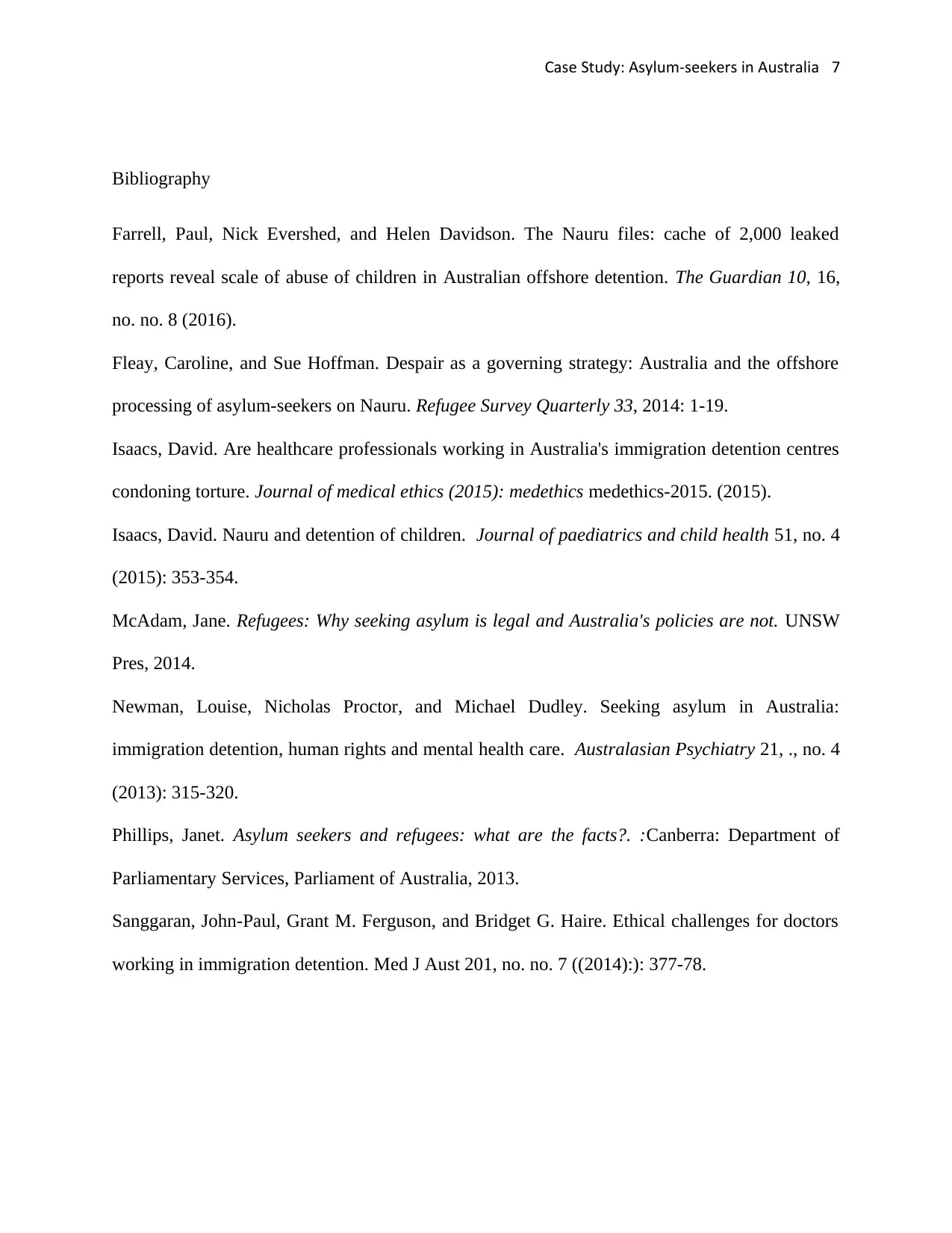
Case Study: Asylum-seekers in Australia 7
Bibliography
Farrell, Paul, Nick Evershed, and Helen Davidson. The Nauru files: cache of 2,000 leaked
reports reveal scale of abuse of children in Australian offshore detention. The Guardian 10, 16,
no. no. 8 (2016).
Fleay, Caroline, and Sue Hoffman. Despair as a governing strategy: Australia and the offshore
processing of asylum-seekers on Nauru. Refugee Survey Quarterly 33, 2014: 1-19.
Isaacs, David. Are healthcare professionals working in Australia's immigration detention centres
condoning torture. Journal of medical ethics (2015): medethics medethics-2015. (2015).
Isaacs, David. Nauru and detention of children. Journal of paediatrics and child health 51, no. 4
(2015): 353-354.
McAdam, Jane. Refugees: Why seeking asylum is legal and Australia's policies are not. UNSW
Pres, 2014.
Newman, Louise, Nicholas Proctor, and Michael Dudley. Seeking asylum in Australia:
immigration detention, human rights and mental health care. Australasian Psychiatry 21, ., no. 4
(2013): 315-320.
Phillips, Janet. Asylum seekers and refugees: what are the facts?. :Canberra: Department of
Parliamentary Services, Parliament of Australia, 2013.
Sanggaran, John-Paul, Grant M. Ferguson, and Bridget G. Haire. Ethical challenges for doctors
working in immigration detention. Med J Aust 201, no. no. 7 ((2014):): 377-78.
Bibliography
Farrell, Paul, Nick Evershed, and Helen Davidson. The Nauru files: cache of 2,000 leaked
reports reveal scale of abuse of children in Australian offshore detention. The Guardian 10, 16,
no. no. 8 (2016).
Fleay, Caroline, and Sue Hoffman. Despair as a governing strategy: Australia and the offshore
processing of asylum-seekers on Nauru. Refugee Survey Quarterly 33, 2014: 1-19.
Isaacs, David. Are healthcare professionals working in Australia's immigration detention centres
condoning torture. Journal of medical ethics (2015): medethics medethics-2015. (2015).
Isaacs, David. Nauru and detention of children. Journal of paediatrics and child health 51, no. 4
(2015): 353-354.
McAdam, Jane. Refugees: Why seeking asylum is legal and Australia's policies are not. UNSW
Pres, 2014.
Newman, Louise, Nicholas Proctor, and Michael Dudley. Seeking asylum in Australia:
immigration detention, human rights and mental health care. Australasian Psychiatry 21, ., no. 4
(2013): 315-320.
Phillips, Janet. Asylum seekers and refugees: what are the facts?. :Canberra: Department of
Parliamentary Services, Parliament of Australia, 2013.
Sanggaran, John-Paul, Grant M. Ferguson, and Bridget G. Haire. Ethical challenges for doctors
working in immigration detention. Med J Aust 201, no. no. 7 ((2014):): 377-78.
1 out of 7
Related Documents
Your All-in-One AI-Powered Toolkit for Academic Success.
+13062052269
info@desklib.com
Available 24*7 on WhatsApp / Email
![[object Object]](/_next/static/media/star-bottom.7253800d.svg)
Unlock your academic potential
Copyright © 2020–2025 A2Z Services. All Rights Reserved. Developed and managed by ZUCOL.





